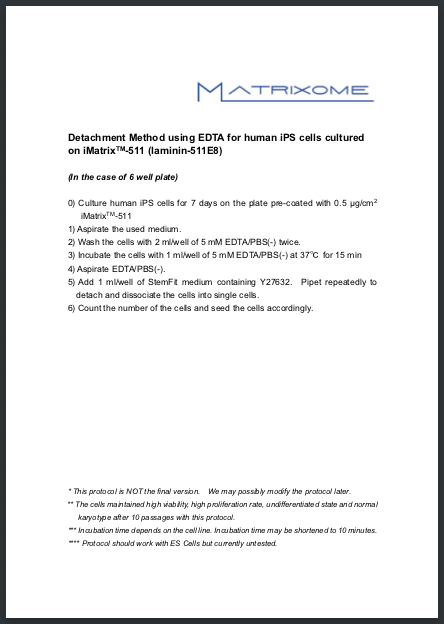Scraper-Free Detachment using iMatrix
Scraper-Free Detachment using iMatrix™ (laminin-511E8)
Matrixome’s iMatrix™ product line of laminin E8 fragments enables researchers to culture and passage their iPS and ES cells, in new and more efficient methods. From the “Pre-Mix Method“, which allows you to skip the pre-coating of your plates saving researchers both valuable time and money, to now the scraper free method of detaching and passaging your stem cell lines.Recombinant laminin-511E8 fragment (laminin-511E8 or iMatrix™-511) is a truncated form of laminin-511 containing the binding site for the integrin α6β1, an isoform predominantly expressed on human pluripotent stem cells (hPSCs). The strong interaction of laminin-511E8 with integrin α6β1 enables hPSCs to preserve pluripotency, retain an undifferentiated state and sustain long-term single cell passaging. However, because of their strong interaction, trypsinization followed by scraping is recommended to harvest the cells. Nevertheless, cell scraping causes mechanical damage to the cells, thereby reducing cell viability. Moreover, cell scraping is not applicable for multi-layer flasks or in automated cell culture systems. In this study, we aim to develop a scraper-free cell detachment method for human induced pluripotent stem cells (hiPSCs) cultured on LM511E8, focusing on detachment reagents. By referring to the protocols available to date, we examined whether incubation of hiPSCs with 5 mM EDTA/PBS(-) at 37˚C for 15 min enabled the cell detachment at high efficiency. The inclusion of TrypLETM Select or recombinant trypsin (rtrypsin) to EDTA/PBS(-) was also tested to see if there were any additional gains for cell detachment efficiency. We found that more than 95% of hiPSCs were detached without compromising cell viability when they were incubated with 5 mM EDTA/PBS(-) alone. Surprisingly, the addition of trypsin decreased the detachment efficiency. This decrease was rescued when enough trypsin inhibitor was added to neutralize the enzyme activity, therefore the lowered detachment rate must be a result of its trypsin activity. The protocol is available for download down below. If you are interested in receiving a copy of the poster* presented at ISSCR 2019 (a new updated version is available which was presented at KSSCR 2019), please send a request via our contact form.

*The poster is considered “Confidential” as poster data is to be published. ・ Please read only those concerned. ・ Do not duplicate. ・ Do not print. ・ Currently in the research stage, so method may change.
This poster was first presented at ISSCR 2019 by Dr. Fumi Ebisu. Dr. Fumi Ebisu graduated with her bachelor’s degree in Clinical Laboratory Science from Eastern Michigan University where she further went to pursue her Master’s in Chemistry. Later on, she received her Ph.D. in Neuroscience from University of Michigan thanks to her thesis on “Macrophage migration inhibitory factor acts as a neurotrophin in the developing inner ear”. She then went on to work as a Post-Doctoral fellow at the Otolaryngology Department at Kyoto University. She is now a visiting research scholar at the Institute for Protein Research at Osaka University and the Project Leader at Matrixome, Inc.


